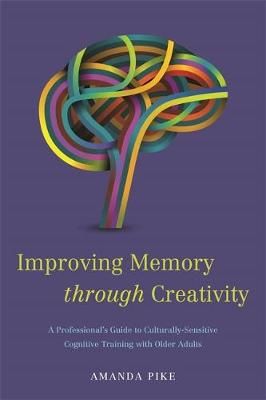
Improving Memory through Creativity: A Professional's Guide to Culturally Sensitive Cognitive Training with Older Adults
- Author: Pike, Amanda
Book
$28.25Contents
- 1. Late-Life Creative Self-Expression and Memory.
- 1.1. How-to-Apply Information Presented within this Text.
- 1.2. Normal and Abnormal Aging.
- 1.3. Alzheimer's disease.
- 1.4. Risk Factors of Memory Loss.
- 1.5. Mental Stimulation.
- 1.6. Stress.
- 1.7. Emotional Stress and Social Isolation.
- 1.8. Self-Expression in Late-Life.
- 1.9. Encouraging Mental Stimulation through Expressive Art-Making.
- 1.10. Incorporating Creativity into Older Adult Identity through Art-Making.
- 1.11. Creative Behavior.
- 1.12. Creative Thought.
- 1.13. Creative Self-Expression.
- 1.14. Summary.
- 2. Happiness, Social Creativity, and the Brain.
- 2.1. Happiness and Creative Self-Expression.
- 2.2. Elevating Mood during Creative Sessions.
- 2.3. Bodily/Sensory Pleasures.
- 2.4. Higher Order Pleasures.
- 2.5. Gratifications.
- 2.6. Happiness, Creativity and the Brain.
- 2.7. Neurotransmitters and Creativity.
- 2.8. Making Art that Expresses and Enhances Mood.
- 2.9. Visual Elements, Cognition and Mood.
- 2.10. Combining Visual Elements for Enhanced Mood.
- 2.11. Social Equality vs. Stratifications during Creativity and Happiness.
- 2.12. Summary.
- 3. Culture, Communication and Art.
- 3.1. Promoting Socialization during Memory Training.
- 3.2. Culture.
- 3.3. Providing Cultural Neutrality.
- 3.4. Communication.
- 3.5. Art in Communication.
- 3.6. Visual Literacy.
- 3.7. Social Sharing of Meaning through Art.
- 3.8. Social Roles.
- 3.9. Increased Socialization through Art.
- 3.10. Summary.
- 4. Cognitive Training through Creative Self-Expression.
- 4.1. Addressing Cognitive Abilities.
- 4. 2 Emotion-Focused Interventions.
- 4.3. Targeting Cognitive Performance through Creativity.
- 4.4. Nature of Cognitive Impairment.
- 4.5. Type of Memory Impacted.
- 4.6. Short-term Working Memory vs Long-term Memory.
- 4.7. Cognitive Training.
- 4.8. Restorative Strategies.
- 4.9. Compensatory Strategies.
- 4.10. Expressivity-based Memory Techniques.
- 4.11. Neurobiology of Creativity and Expressivity.
- 4.12. Theory: Going Beyond "Recipes".
- 4.13. Understanding Cerebral Activity in Art-Making.
- 4.14. Examples of artwork and corresponding ETC.
- 4.15. Educational vs Therapeutic Frameworks.
- 4.16. Summary.
- 5. Understanding Art to Understand the Mind.
- 5.1. Elements of Successful Sessions.
- 5.2. Additional Planning for Effective Sessions.
- 5.3. Rhythmic Structure and Versatility in Directives.
- 5.3. Outline of Ten-Weeks of Sessions.
- 5.4. A Single Directive for All Ten-Weeks.
- 5. 5 Concluding the Ten Weeks.
- 5.6. Summary.
- 6. Going beyond the Book: Community Collaborations.
- 6.1. Scope-of-Practice.
- 6.2. Cultural Trends in Seeking Care.
- 6.3. Caregivers.
- 6.4. Inter-Generational Projects.
- 6.5. Services/Systems of Care across Settings.
- 6.6. Getting Started.
- 6.7. Identifying Symptoms Cross-Culturally.
- 6.8. Organizations.
- 6.9. Ways to Continue Learning.
- 6.10. Summary.
- 6.11. Learning Evaluation Quiz. References.


